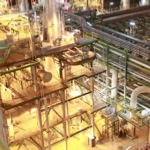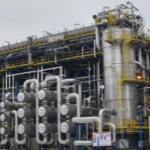Application: Solvent deasphalting (SDA) is used as part of a bottom-of-the-barrel upgrading solution that separates higher quality components from heavy residues and other heavy petroleum feedstocks using solvent extraction and supercritical solvent recovery technology.
Description: Heavy feedstock is diluted with a light paraffinic solvent and then charged to a vertical extractor tower. Within the tower, a deasphalted oil (DAO) fraction dissolves in the solvent and the remaining heavy components are precipitated. The DAO and solvent mixture exits the top of the extractor and is heated to create a supercritical solvent phase that is then separated from the liquid DAO phase. Any remaining solvent is removed in a stripper column, and the DAO product is then typically sent as a quality feedstock to fuels cracking processes or used in the production of lubricating oils. Pitch with some entrained solvent is withdrawn from the bottom of the extractor and sent to a pitch stripping section. The pitch can be used in specification asphalts, as fuel, or as feedstock to conversion units such as a delayed coker or gasifier. If desired, a second extraction stage is utilized to produce an intermediate resin product.
Operating conditions: Typical extraction conditions are given below:
Solvent – Typically pure or blended C3-C7 paraffins, including light naphthas
Extraction Pressure, psig – 500-700
Extraction Temperature, °F – 120-400
Solvent to Oil ratio – 4:1 to 10:1
Yields: The depth of extraction can be tailored to each specific application, and may vary widely since yield/quality is dependent on the molecular species present in the feedstock. Below are two examples with widely varying
| Lubes Application (C3 solvent) | High-Lift Fuels Application (C5 solvent) | |
|---|---|---|
| Feed | ||
| Specific Gravity | 0.995 | 1.047 |
| Sulfur, wt% | 1.48 | 1.88 |
| Conradson carbon residue (CCR), wt% | 16.0 | 27.2 |
| Metals (Ni + V), wt ppm | 98 | 239 |
| DAO | ||
| Yield vol% of feed | 31 | 81 |
| Specific gravity | 0.9232 | 0.997 |
| Sulfur, wt% | 0.89 | 1.5 |
| CCR, wt% | 2.5 | 14.0 |
| Metals, (Ni + V), wt ppm | < 2 | 32 |
| Pitch | ||
| Ring and ball softening point, °F | 130 | 425 |
| Specific Gravity | 1.02 | 1.26 |
Advantages: The Wood Foster Wheeler/ UOP SDA process is a state-of-the-art solvent extraction process incorporating supercritical solvent recovery, and is capable of achieving the highest product quality with the lowest operating costs. The technology incorporates a long history of proven deasphalting and heavy oils experience and is designed to ensure reliable operations.
Economics:
Investment: Deasphalting should be considered when selecting any modern bottom-of-the-barrel upgrading scheme. Stand-alone units or residue blocks incorporating deasphalting are often attractive due to a much lower investment cost, typically leading to higher overall project internal rates of return (IRRs).
Utilities: Utility consumption can vary greatly depending upon processing objectives. Typical values are listed below. Heat input is typically provided by steam or hot oil.
Electricity, kWh – 1.6 per barrel of feed
Stripping Steam (150 psig), lb – 11 per barrel of feed
Heat Absorbed, MM Btu – 0.080 per barrel of feed
Process Flow Diagram 
Development/Delivery: Joint licensors UOP and Wood Foster Wheeler have well-established experience in licensor technology packages, front-end engineering, EPC, operating unit support, and pilot plant testing.
Installations: Over 60 units licensed or designed, with single trains up to 50,000 BPSD.
References:
1. Handbook of Petroleum Refining Processes, Fourth Ed., McGraw Hill, 2016, pp. 475 – 495
2. “Solvent Deasphalting Options: How SDA can Increase Residue Upgrading Margins”, Middle East Technology Forum, Dubai, February 2014
Licensor: Wood Foster Wheeler / UOP















